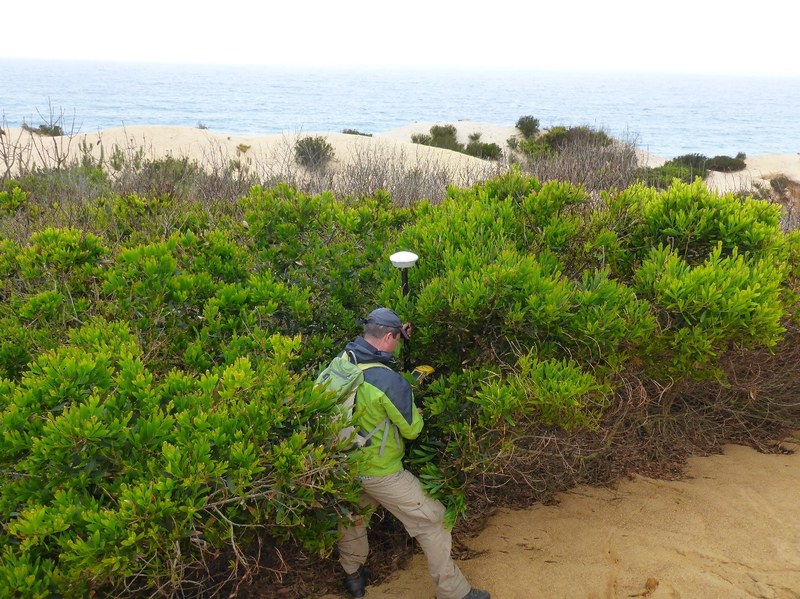QUEEN
Quantifying the spatial impact of exotic plant invasion on ecosystem functioning - from the leaf to landscape level
Exotic invasive species represent a major threat to earths biodiversity, since they substantially alter biogeochemical cycles of ecosystems with large impacts on ecosystem functioning. However, to date, explicitly quantifying such impacts remains challenging. One reason is the lack of adequate methodology to capture the spatial dimension of ecosystem changes associated with biological invasion. Conventional ecophysiological approaches are largely restricted to comparing neighbouring plant individuals and tend to neglect the spatial dimension. Landscape ecology, although operating on larger spatial scales, is typically limited to measurements of patterns and processes above the organism level, such as species distribution and propagation speed. The central aim of this project is to link ecophysiology with landscape ecology, thus moving towards an integrated understanding of the spatial aspect of plant invasions, enabling the quantification of exotic species impacts across spatial scales. A highly suitable technology to address this purpose is hyperspectral remote sensing, which allows for quantifying alterations in native species biochemistry on the leaf level using spectral measurements while allowing to scale up to the landscape level using aerial images. Utilizing the case study of the N2-fixing leguminous tree Acacia longifolia, a problematic invader in coastal regions of Portugal and many ecosystems worldwide, we will develop new methodology for quantifying changes in ecosystem functioning after plant invasion from the leaf to the landscape scale.

Participating scientists and institutions: Dr. André Große-Stoltenberg (JLU), Prof. Dr. Christiane Werner, Dr. Christiane Hellmann (Albert-Ludwigs-Universität Freiburg), PD Dr. Jan Thiele (Johann Heinrich von Thünen-Institut), Dr. Jens Oldeland (Universität Hamburg)
Duration: 2013-2016
Funding: DFG
Publications:
- Große-Stoltenberg A., Hellmann C., Thiele J., Werner C. & Oldeland J (2018): Early detection of GPP-related regime shifts after plant invasion by integrating imaging spectroscopy with airborne LiDAR. Remote Sensing of Environment 209: 780–792.
- Große-Stoltenberg, A.*; Hellmann, C.*; Thiele, J., Oldeland, J. & Werner, C. (2018): Invasive acacias differ from native dune species in the hyperspectral/ biochemical trait space. Journal of Vegetation Science 29: 325-335. *Geteilte Ko-Autorenschaft
- Hellmann, C., Große-Stoltenberg A., Thiele J., Oldeland J. & Werner C. (2017): Heterogeneous environments shape invader impacts: integrating environmental, structural and functional effects by isoscapes and remote sensing. Scientific Reports 7:4118.
- Große-Stoltenberg, A., Werner, C., Hellmann, C., Oldeland, J. & Thiele, J. (2016): Evaluation of Continuous VNIR-SWIR Spectra versus Narrowband Hyperspectral Indices to Discriminate the Invasive Acacia longifolia within a Mediterranean Dune Ecosystem. Remote Sensing 8:334.
- Hellmann, C., Rascher, K., Oldeland, J. & Werner, C. (2016): Isoscapes resolve species-specific spatial patterns in plant-plant interactions in an invaded Mediterranean dune ecosystem. Tree Physiology 36:1460–1470.
- Hellmann C., Werner C. & Oldeland J. (2016): A Spatially Explicit Dual-Isotope Approach to Map Regions of Plant-Plant Interaction after Exotic Plant Invasion. PLos ONE 11: e0159403.
- Heim, R., Jürgens, N., Große-Stoltenberg, A. & Oldeland, J. (2015): The Effect of Epidermal Structures on Leaf Spectral Signatures of Ice Plants (Aizoaceae). Remote Sensing 7:16901–16914.
- Hellmann C., Große-Stoltenberg A., Lauströer V., Oldeland J. & Werner C. (2015): Retrieving nitrogen isotopic signatures from fresh leaf reflectance spectra: disentangling δ15N from biochemical and structural leaf properties. Frontiers in Plant Science 6: 307.
- Lehmann, J., Große-Stoltenberg, A., Römer, M. & Oldeland, J. (2015). Field Spectroscopy in the VNIR-SWIR Region to Discriminate between Mediterranean Native Plants and Exotic-Invasive Shrubs Based on Leaf Tannin Content. Remote Sensing 7:1225–1241.

Awards:
- Dr. Christine Hellmann: Isotope-Prize of the Habfast-Foundation, Arbeitsgemeinschaft Stabiler Isotope (ASI) / German Association for Stable Isotope Research (Gasir), 2017.
- Dr. André Große-Stoltenberg: Helmut-Lieth-Prize for Environmental Sciences Albert-Ludwigs-Universität Freiburg, 2018.
